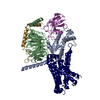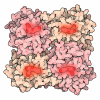[English] 日本語
 Yorodumi
Yorodumi- PDB-7wuj: Tethered peptide activation mechanism of adhesion GPCRs ADGRG2 an... -
+ Open data
Open data
- Basic information
Basic information
| Entry | Database: PDB / ID: 7wuj | |||||||||
|---|---|---|---|---|---|---|---|---|---|---|
| Title | Tethered peptide activation mechanism of adhesion GPCRs ADGRG2 and ADGRG4 | |||||||||
 Components Components |
| |||||||||
 Keywords Keywords | MEMBRANE PROTEIN / GPCR / ADGRG4 | |||||||||
| Function / homology |  Function and homology information Function and homology informationbioluminescence / generation of precursor metabolites and energy / G protein-coupled receptor activity / Olfactory Signaling Pathway / adenylate cyclase-activating G protein-coupled receptor signaling pathway / Activation of the phototransduction cascade / G beta:gamma signalling through PLC beta / Presynaptic function of Kainate receptors / Thromboxane signalling through TP receptor / G protein-coupled acetylcholine receptor signaling pathway ...bioluminescence / generation of precursor metabolites and energy / G protein-coupled receptor activity / Olfactory Signaling Pathway / adenylate cyclase-activating G protein-coupled receptor signaling pathway / Activation of the phototransduction cascade / G beta:gamma signalling through PLC beta / Presynaptic function of Kainate receptors / Thromboxane signalling through TP receptor / G protein-coupled acetylcholine receptor signaling pathway / Activation of G protein gated Potassium channels / Inhibition of voltage gated Ca2+ channels via Gbeta/gamma subunits / G-protein activation / Prostacyclin signalling through prostacyclin receptor / G beta:gamma signalling through CDC42 / Glucagon signaling in metabolic regulation / G beta:gamma signalling through BTK / Synthesis, secretion, and inactivation of Glucagon-like Peptide-1 (GLP-1) / ADP signalling through P2Y purinoceptor 12 / photoreceptor disc membrane / Sensory perception of sweet, bitter, and umami (glutamate) taste / Glucagon-type ligand receptors / Adrenaline,noradrenaline inhibits insulin secretion / Vasopressin regulates renal water homeostasis via Aquaporins / Glucagon-like Peptide-1 (GLP1) regulates insulin secretion / G alpha (z) signalling events / cellular response to catecholamine stimulus / ADORA2B mediated anti-inflammatory cytokines production / ADP signalling through P2Y purinoceptor 1 / G beta:gamma signalling through PI3Kgamma / Cooperation of PDCL (PhLP1) and TRiC/CCT in G-protein beta folding / adenylate cyclase-activating dopamine receptor signaling pathway / GPER1 signaling / Inactivation, recovery and regulation of the phototransduction cascade / cellular response to prostaglandin E stimulus / G-protein beta-subunit binding / heterotrimeric G-protein complex / G alpha (12/13) signalling events / sensory perception of taste / extracellular vesicle / signaling receptor complex adaptor activity / Thrombin signalling through proteinase activated receptors (PARs) / retina development in camera-type eye / GTPase binding / Ca2+ pathway / fibroblast proliferation / High laminar flow shear stress activates signaling by PIEZO1 and PECAM1:CDH5:KDR in endothelial cells / G alpha (i) signalling events / G alpha (s) signalling events / phospholipase C-activating G protein-coupled receptor signaling pathway / G alpha (q) signalling events / Ras protein signal transduction / cell surface receptor signaling pathway / Extra-nuclear estrogen signaling / cell population proliferation / G protein-coupled receptor signaling pathway / lysosomal membrane / GTPase activity / synapse / protein-containing complex binding / signal transduction / extracellular exosome / membrane / plasma membrane / cytosol / cytoplasm Similarity search - Function | |||||||||
| Biological species |  Homo sapiens (human) Homo sapiens (human) Psychromonas sp. B3M02 (bacteria) Psychromonas sp. B3M02 (bacteria)synthetic construct (others)  | |||||||||
| Method | ELECTRON MICROSCOPY / single particle reconstruction / cryo EM / Resolution: 3.3 Å | |||||||||
 Authors Authors | Guo, S.C. / Huang, S.M. / He, Q.T. / Xiao, P. / Sun, J.P. / Yu, X. | |||||||||
| Funding support |  China, 2items China, 2items
| |||||||||
 Citation Citation |  Journal: Nature / Year: 2022 Journal: Nature / Year: 2022Title: Tethered peptide activation mechanism of the adhesion GPCRs ADGRG2 and ADGRG4. Authors: Peng Xiao / Shengchao Guo / Xin Wen / Qing-Tao He / Hui Lin / Shen-Ming Huang / Lu Gou / Chao Zhang / Zhao Yang / Ya-Ni Zhong / Chuan-Cheng Yang / Yu Li / Zheng Gong / Xiao-Na Tao / Zhi- ...Authors: Peng Xiao / Shengchao Guo / Xin Wen / Qing-Tao He / Hui Lin / Shen-Ming Huang / Lu Gou / Chao Zhang / Zhao Yang / Ya-Ni Zhong / Chuan-Cheng Yang / Yu Li / Zheng Gong / Xiao-Na Tao / Zhi-Shuai Yang / Yan Lu / Shao-Long Li / Jun-Yan He / Chuanxin Wang / Lei Zhang / Liangliang Kong / Jin-Peng Sun / Xiao Yu /  Abstract: Adhesion G protein-coupled receptors (aGPCRs) constitute an evolutionarily ancient family of receptors that often undergo autoproteolysis to produce α and β subunits. A tethered agonism mediated by ...Adhesion G protein-coupled receptors (aGPCRs) constitute an evolutionarily ancient family of receptors that often undergo autoproteolysis to produce α and β subunits. A tethered agonism mediated by the 'Stachel sequence' of the β subunit has been proposed to have central roles in aGPCR activation. Here we present three cryo-electron microscopy structures of aGPCRs coupled to the G heterotrimer. Two of these aGPCRs are activated by tethered Stachel sequences-the ADGRG2-β-G complex and the ADGRG4-β-G complex (in which β indicates the β subunit of the aGPCR)-and the other is the full-length ADGRG2 in complex with the exogenous ADGRG2 Stachel-sequence-derived peptide agonist IP15 (ADGRG2(FL)-IP15-G). The Stachel sequences of both ADGRG2-β and ADGRG4-β assume a U shape and insert deeply into the seven-transmembrane bundles. Constituting the FXφφφXφ motif (in which φ represents a hydrophobic residue), five residues of ADGRG2-β or ADGRG4-β extend like fingers to mediate binding to the seven-transmembrane domain and activation of the receptor. The structure of the ADGRG2(FL)-IP15-G complex reveals the structural basis for the improved binding affinity of IP15 compared with VPM-p15 and indicates that rational design of peptidic agonists could be achieved by exploiting aGPCR-β structures. By converting the 'finger residues' to acidic residues, we develop a method to generate peptidic antagonists towards several aGPCRs. Collectively, our study provides structural and biochemical insights into the tethered activation mechanism of aGPCRs. | |||||||||
| History |
|
- Structure visualization
Structure visualization
| Structure viewer | Molecule:  Molmil Molmil Jmol/JSmol Jmol/JSmol |
|---|
- Downloads & links
Downloads & links
- Download
Download
| PDBx/mmCIF format |  7wuj.cif.gz 7wuj.cif.gz | 233.7 KB | Display |  PDBx/mmCIF format PDBx/mmCIF format |
|---|---|---|---|---|
| PDB format |  pdb7wuj.ent.gz pdb7wuj.ent.gz | 169.3 KB | Display |  PDB format PDB format |
| PDBx/mmJSON format |  7wuj.json.gz 7wuj.json.gz | Tree view |  PDBx/mmJSON format PDBx/mmJSON format | |
| Others |  Other downloads Other downloads |
-Validation report
| Summary document |  7wuj_validation.pdf.gz 7wuj_validation.pdf.gz | 939.3 KB | Display |  wwPDB validaton report wwPDB validaton report |
|---|---|---|---|---|
| Full document |  7wuj_full_validation.pdf.gz 7wuj_full_validation.pdf.gz | 964 KB | Display | |
| Data in XML |  7wuj_validation.xml.gz 7wuj_validation.xml.gz | 36.8 KB | Display | |
| Data in CIF |  7wuj_validation.cif.gz 7wuj_validation.cif.gz | 56.7 KB | Display | |
| Arichive directory |  https://data.pdbj.org/pub/pdb/validation_reports/wu/7wuj https://data.pdbj.org/pub/pdb/validation_reports/wu/7wuj ftp://data.pdbj.org/pub/pdb/validation_reports/wu/7wuj ftp://data.pdbj.org/pub/pdb/validation_reports/wu/7wuj | HTTPS FTP |
-Related structure data
| Related structure data |  32837MC  7wuiC  7wuqC M: map data used to model this data C: citing same article ( |
|---|---|
| Similar structure data | Similarity search - Function & homology  F&H Search F&H Search |
- Links
Links
- Assembly
Assembly
| Deposited unit | 
|
|---|---|
| 1 |
|
- Components
Components
-Protein , 2 types, 2 molecules AE
| #1: Protein | Mass: 41879.465 Da / Num. of mol.: 1 Source method: isolated from a genetically manipulated source Source: (gene. exp.)  Homo sapiens (human) / Production host: Homo sapiens (human) / Production host:  Baculovirus expression vector pFastBac1-HM Baculovirus expression vector pFastBac1-HM |
|---|---|
| #3: Protein | Mass: 71627.969 Da / Num. of mol.: 1 Source method: isolated from a genetically manipulated source Details: residues 3081-3088 = His tag, residues 3089-3091 = linker, residues 3092-3098 = TEV site Source: (gene. exp.)  Homo sapiens (human), (gene. exp.) Homo sapiens (human), (gene. exp.)  Psychromonas sp. B3M02 (bacteria) Psychromonas sp. B3M02 (bacteria)Gene: ADGRG4, GPR112, DS885_16260 / Production host:  Baculovirus expression vector pFastBac1-HM / References: UniProt: Q8IZF6, UniProt: A0A366VY15 Baculovirus expression vector pFastBac1-HM / References: UniProt: Q8IZF6, UniProt: A0A366VY15 |
-Guanine nucleotide-binding protein ... , 2 types, 2 molecules BY
| #2: Protein | Mass: 39489.160 Da / Num. of mol.: 1 Source method: isolated from a genetically manipulated source Source: (gene. exp.)  Homo sapiens (human) / Gene: GNB1 / Production host: Homo sapiens (human) / Gene: GNB1 / Production host:  Baculovirus expression vector pFastBac1-HM / References: UniProt: P62873 Baculovirus expression vector pFastBac1-HM / References: UniProt: P62873 |
|---|---|
| #5: Protein | Mass: 7861.143 Da / Num. of mol.: 1 Source method: isolated from a genetically manipulated source Source: (gene. exp.)  Homo sapiens (human) / Gene: GNG2 / Production host: Homo sapiens (human) / Gene: GNG2 / Production host:  Baculovirus expression vector pFastBac1-HM / References: UniProt: P59768 Baculovirus expression vector pFastBac1-HM / References: UniProt: P59768 |
-Antibody , 2 types, 2 molecules SN
| #4: Antibody | Mass: 26610.615 Da / Num. of mol.: 1 Source method: isolated from a genetically manipulated source Source: (gene. exp.) synthetic construct (others) / Production host:  Baculovirus expression vector pFastBac1-HM Baculovirus expression vector pFastBac1-HM |
|---|---|
| #6: Antibody | Mass: 13885.439 Da / Num. of mol.: 1 Source method: isolated from a genetically manipulated source Source: (gene. exp.)   Escherichia phage EcSzw-2 (virus) Escherichia phage EcSzw-2 (virus) |
-Details
| Has protein modification | Y |
|---|
-Experimental details
-Experiment
| Experiment | Method: ELECTRON MICROSCOPY |
|---|---|
| EM experiment | Aggregation state: PARTICLE / 3D reconstruction method: single particle reconstruction |
- Sample preparation
Sample preparation
| Component |
| ||||||||||||||||||||||||||||||
|---|---|---|---|---|---|---|---|---|---|---|---|---|---|---|---|---|---|---|---|---|---|---|---|---|---|---|---|---|---|---|---|
| Source (natural) |
| ||||||||||||||||||||||||||||||
| Source (recombinant) |
| ||||||||||||||||||||||||||||||
| Buffer solution | pH: 7.5 | ||||||||||||||||||||||||||||||
| Specimen | Embedding applied: NO / Shadowing applied: NO / Staining applied: NO / Vitrification applied: YES | ||||||||||||||||||||||||||||||
| Vitrification | Cryogen name: ETHANE |
- Electron microscopy imaging
Electron microscopy imaging
| Experimental equipment |  Model: Titan Krios / Image courtesy: FEI Company |
|---|---|
| Microscopy | Model: FEI TITAN KRIOS |
| Electron gun | Electron source:  FIELD EMISSION GUN / Accelerating voltage: 300 kV / Illumination mode: SPOT SCAN FIELD EMISSION GUN / Accelerating voltage: 300 kV / Illumination mode: SPOT SCAN |
| Electron lens | Mode: BRIGHT FIELD / Nominal defocus max: 2500 nm / Nominal defocus min: 1000 nm |
| Image recording | Electron dose: 64 e/Å2 / Film or detector model: GATAN K2 SUMMIT (4k x 4k) |
- Processing
Processing
| CTF correction | Type: PHASE FLIPPING AND AMPLITUDE CORRECTION |
|---|---|
| 3D reconstruction | Resolution: 3.3 Å / Resolution method: FSC 0.143 CUT-OFF / Num. of particles: 619803 / Symmetry type: POINT |
 Movie
Movie Controller
Controller




 PDBj
PDBj




















